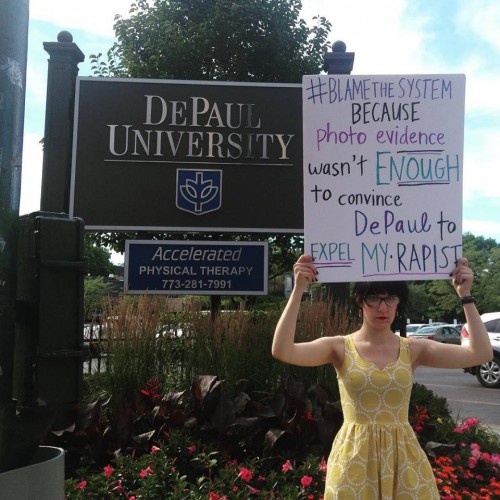
Women and men marched together in the Loop last Sunday to speak out against rape, rape culture and gender violence in a demonstration organized by the group Feminist Uprising to Resist Inequality and Exploitation, or FURIE.
The march, called Blame the System Not the Victim, focused on the fight against “rape on college campuses to police violence targeting women and trans people of color and systemic gender violence permeating all levels of society,” according to the group’s Facebook page.
Among those in attendance was Meagan Anderson, a survivor of sexual violence whose Instagram picture has gone viral. In the photo, she is standing next to a DePaul University sign holding up a poster that reads, “#blamethesystem because photo evidence wasn’t enough to convince DePaul to expel my rapist.”
The post has been shared on Facebook more than 1,000 times, many by DePaul students, highlighting the ongoing issue of sexual assault on campus and how universities are handling that problem.
In a response to questions regarding the photo, a spokeswoman for the university said due to “federal legislation that protects the privacy of student records, federal law prohibits us from discussing the details of specific cases.”
However, they added that “lack of information regarding details of specific incidents involving students and the Student Conduct Process should not be misconstrued as lack of action on the part of the university. Most important, DePaul is committed to providing and maintaining a healthy learning and working environment that is free of sexual and relationship violence.”
In cases like Anderson’s, the university said it follows a student conduct process.
[box]View general information about the student conduct process here. [/box]
At DePaul, there have been other protests focusing on sexual assault and the way the university’s administration has handled them — most notably the banner drop in Arts and Letters Hall a year ago, as well as Take Back the Night and Carry that Weight — but FURIE’s protest allowed Anderson, and those like her, to speak out about the injustices within the system not just for themselves, but for others in similar situations.
“In the past, I’d never felt like I had the strength and togetherness to make a sign and march and yell about things I care about,” Anderson said of the experience. She had never protested before.
A report by the White House Council on Women and Girls issued in January 2014 found that one in five women, or nearly 22 million women, and one in 71 men, or nearly 1.6 million, have been raped in their lifetimes. In about 80 percent of the assaults, according to the Bureau of Justice Statistics, the offender was known to the victim, which is true in Anderson’s case.
Sunday’s march was not the first of its kind, but it did come close to home. It allowed senior Theresa Bailey to reflect on her own experience as a sexual violence survivor, and as an ally to Anderson, she said. She believes dialogue is perhaps one way forward, though change may not be right around the corner. As for whether or not these protests are helpful, Bailey has mixed feelings.
“They bring attention to issues, such as these, but I don’t think a march is always the best way to change minds,” Bailey said about possibilities for change. “I (don’t think it will happen) in the next five years. But in the next 50? Yes. I think open discussion of consent has been a change of the last few years.”
Though Anderson and Bailey feel that marches like these are helpful in increasing awareness, they agree that more has to be done to “change minds.”
Better education on these matters and encouraging people to listen to victims without demanding they explain themselves, Bailey suggested, is one way to begin making broader systemic changes on campus and across the country.
“In the moment, it feels like it, with all the energy and the passersby stopping to take video or give a shout of approval. But I’ve never seen a smaller protest like this be addressed by a member of university administration or a lawmaker,” Anderson said about the potential for marches in regards to change.
“As much as I’d like to think that these things actually can effect change, I don’t think the societal change will happen until the people with the real influence address what’s going on and show their support,” she said. “Right now it’s just one person at a time.”




Brandon M. • Jul 23, 2015 at 10:59 pm
I think the part about “lack of information regarding details of specific incidents involving students and the Student Conduct Process should not be misconstrued as lack of action on the part of the university. …” says it all. Whatever photographic evidence she has must not have been sufficient.
Sadly, such is 2015; if something doesn’t go your way, blame the system.
Thomas • Jul 24, 2015 at 1:42 pm
With all due respect, I believe that the lack of action on part of the university lies in the punishments for sexual assault violations and failure to simply BELIEVE survivors and their statements, not in the intensity of the investigation. If you go to her Facebook profile, you can see a statement she posted that lists a great deal of evidence presented that’s not just photographic. The university reviewed this information and heard her statement and they still didn’t believe that a violent rapist was deserving of being removed from campus. That’s what people, not just this woman, are taking issue with. This woman’s rapist WAS found guilty. Once again: he was found guilty. HE WAS FOUND GUILTY. And yet he was hardly punished. The University is blatantly disregarding the right of their students to be in a safe environment free of sexual assault. This is a systematic problem, not the complaint of one person.
Kath • Jul 24, 2015 at 2:02 pm
I’d love to know what DePaul views as sufficient evidence…it seems as though nothing is sufficient enough for them. And you understand that the comment released by DePaul is just a PR move to cover their asses, yes? Just because they said that doesn’t mean it’s magically the truth.
I think it’s more sad that in 2015, universities like DePaul are still more worried about their reputation than the health and wellness of their students. Most survivors at DePaul go unheard by the administration (despite evidence) and end up consistently seeing their rapist on campus.
Daniel Fletcher • Jul 23, 2015 at 8:37 pm
Anyone have a link to more info about this? I don’t know the back story about what photo evidence there is and what the police did about it. I did a google search and found nothing other than this article.
Rachel • Jul 23, 2015 at 11:46 pm
The photo evidence was submitted by Ms. Anderson as part of the hearing process, which was done through the school. The police were not involved, but public safety was. There will be more information on this in another article because this is part of a series on sexual assault.